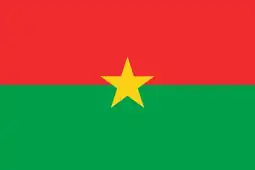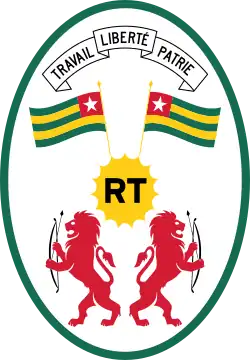
In World War II, French West Africa (Afrique occidentale française, AOF) was not a major scene of major fighting. Only one large-scale action took place there: the Battle of Dakar (23–25 September 1940). The region remained under the control of Vichy France after the fall of France (25 June 1940) and until the Allied invasion of North Africa (8–16 November 1942). French Gabon, the only colony of French Equatorial Africa not to join Free France after the armistice, fell to invading Free French Forces from the neighbouring colonies after the Battle of Gabon (8–12 November 1940), further isolating West Africa.
Unlike in metropolitan France, the French Colonial Troops in West Africa were not reduced after the 1940 armistice and the region was little interfered with by the Axis powers, providing a valuable addition to the forces of Free France after it had been liberated. Before this happened, there was some tension between the French and the neighbouring British colonies, particularly Sierra Leone, leading to the formation of the Freetown Defence Flight in June 1941, but no military incidents took place.
Battle of Dakar
Anti-British sentiment in Africa had run high after the French battleship Richelieu had been hit in the port of Dakar, Senegal, in French West Africa on 10 July 1940.[1] In August, Free French General Charles de Gaulle suggested an overland campaign, landing at Conakry, French Guinea. He anticipated that popular support for the Free French movement would be built in a drive on Dakar. But de Gaulle's suggestion was overruled by British desires to move swiftly.
On 18 September, three French light cruisers, the Georges Leygues, the Gloire, and the Montcalm were intercepted by Allied ships en route to Libreville. The intercepting Allied ships included the heavy cruiser HMAS Australia. The three French light cruisers were forced to retreat.
Vichy resistance stiffened as a result of the attacks on the French ships. The Battle of Dakar (23 September to 25 September 1940) took place after Allied forces failed to persuade the Vichy French defenders of Dakar to allow them to peacefully enter the city. The Allied forces first tried to persuade the Vichy forces by means of propaganda. They then attempted to take Dakar by force of arms. Both attempts ended in defeat. Allied hopes of taking over French West Africa were dashed for the time being, leading to the less developed and economically important French Equatorial Africa to be the main Free French territory in the immediate aftermath of the Armistice.
Battle of Gabon
The Battle of Gabon (French: Bataille du Gabon), also called the Gabon Campaign (Campagne du Gabon), occurred in November 1940 during World War II. The battle resulted in forces under the orders of General Charles de Gaulle taking the colony of Gabon and its capital, Libreville, from Vichy France, and the rallying of French Equatorial Africa to Free France. It was the first military engagement leading to the liberation of France, and the only battle of the war fought in Equatorial Africa – West Africa.
Operation Torch
French West Africa surrendered in Operation Torch to the Allies armies. Dakar Air Base became an important air base.[2]
See also
References
- ↑ "The Second World War in the French Overseas Empire". Retrieved 2006-02-27.
- ↑ "Map of worldwide routes of Air Transport Command, September 1945". Retrieved 6 June 2015.
Further reading
- Akpo-Vaché, Catherine (1996). L'AOF et la Seconde Guerre mondiale: la vie politique, septembre 1939-octobre 1945. Paris: Editions Karthala. ISBN 9782865376407.
- Ginio, Ruth (2008). French Colonialism Unmasked: the Vichy Years in French West Africa. Lincoln: University of Nebraska Press. ISBN 978-0-8032-1746-1.
- Smith, Colin (2009). England's last war against France : fighting Vichy 1940–1942 (1st ed.). London: Weidenfeld & Nicolson. ISBN 978-0-297-85218-6.
- Tute, Warren (1990). The Reluctant Enemies: the Story of the Last War between Britain and France, 1940–1942. London: Collins. ISBN 0-00-215318-1.
- Williams, John (1976). The Guns of Dakar, September 1940. London: Heinemann. ISBN 978-0-434-86630-4.
- Schmidt, Elizabeth (2015). "Popular Resistance and Anticolonial Mobilization: The War Effort in French Guinea". In Byfield, Judith A.; Brown, Carolyn A.; Parsons, Timothy; Sikainga, Ahmad Alawad (eds.). Africa and World War II. Cambridge: Cambridge University Press. pp. 441–461. ISBN 978-1-107-05320-5.
- Lawler, Nancy (1990). "Reform and Repression under the Free French: Economic and Political Transformation in the Côte d'Ivoire, 1942-45". Africa: Journal of the International African Institute. 60 (1): 88–110. doi:10.2307/1160428. ISSN 0001-9720. JSTOR 1160428. S2CID 145346921.
- Yao, Kouassi (1993). "La Côte d'Ivoire pendant la Seconde Guerre mondiale entre fidélité et rupture (1939-1945)". Africa: Rivista trimestrale di studi e documentazione dell'Istituto italiano per l'Africa e l'Oriente. 48 (4): 549–576. ISSN 0001-9747. JSTOR 40760835.
- Ginio, Ruth (2000). "Marshal Petain Spoke to School Children: Vichy Propaganda in French West Africa, 1940-1943". International Journal of African Historical Studies. 33 (2): 291–312. doi:10.2307/220650. ISSN 0361-7882. JSTOR 220650.
External links
- LemaireSoft's Dakar: operation Menace. September 23, 1940
- Ahoy – Mac's Web Log – "Operation Menace." September 23, 24, 25, 1940. HMAS Australia and the debacle at Dakar with General Charles de Gaulle
- Evelyn Waugh – Page 2
- HMAS Australia (II)
.svg.png.webp)



